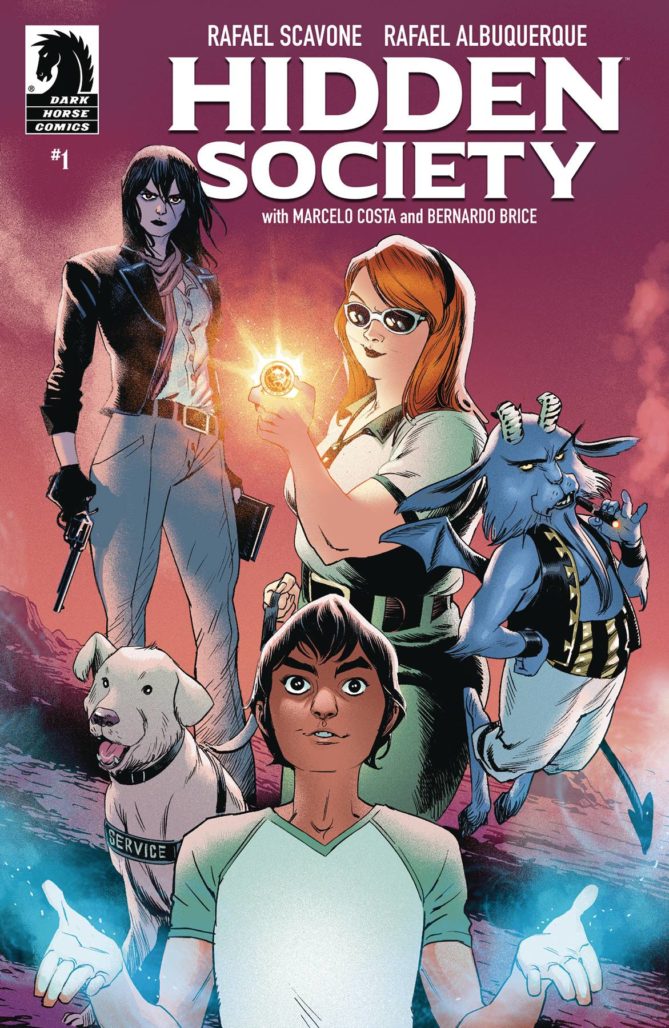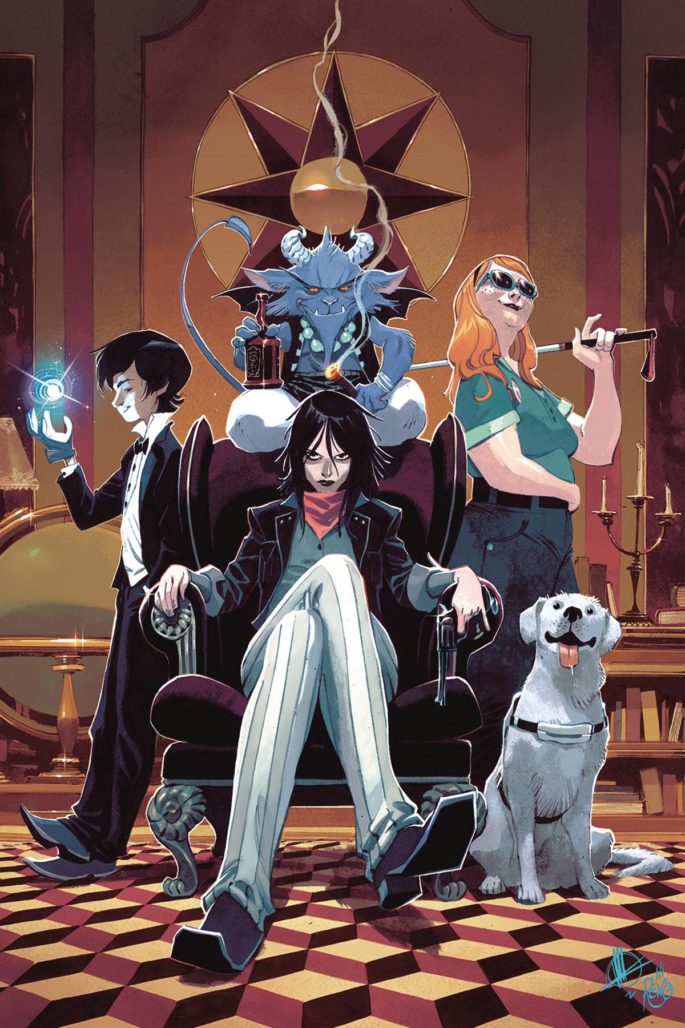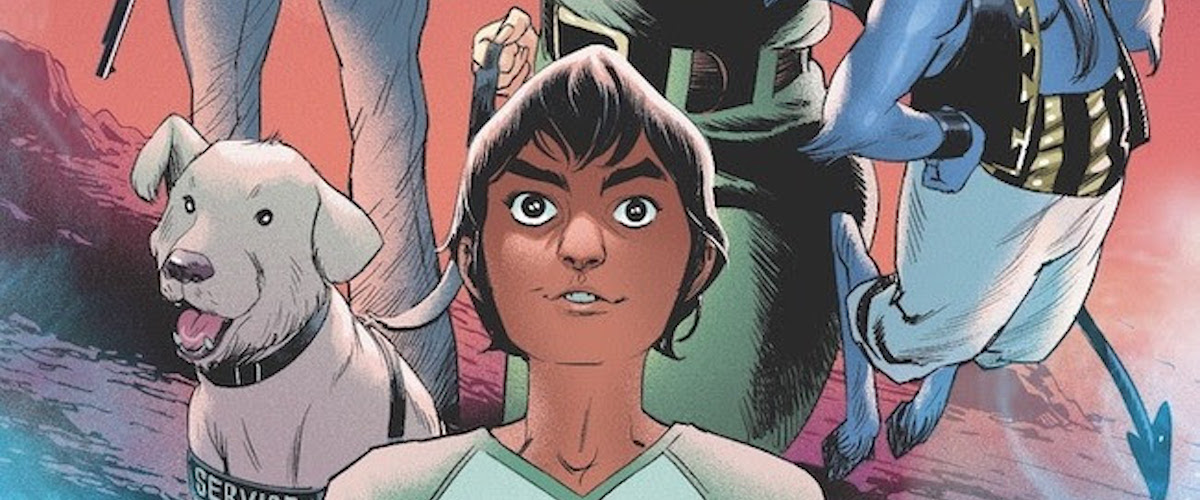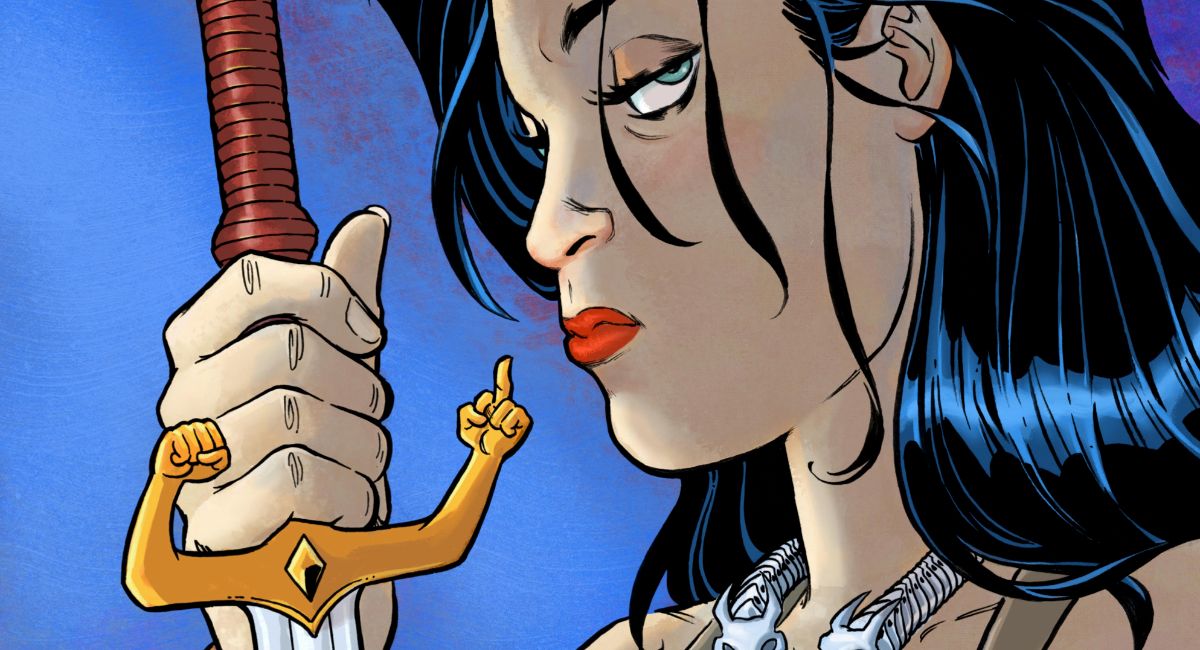
An ancient wizard. A boy entertainer. A blind woman with a guardian demon. A bounty hunter with an unearthly secret. These are the players in the forthcoming Hidden Society, the first creator-owned collaboration from Rafael Scavone and Rafael Albuquerque. Charter members of the four-person Stout Club collective, Scavone and Albuquerque have collaborated previously on titles like Hit-Girl and a graphic novel adaptation of Neil Gaiman‘s Sherlock Holmes-esque tale, A Study in Emerald.
With Hidden Society, the Rafas introduce a world similar to our own—specifically similar to the New York of the late 1970s—in which a dark energy flows just below the surface. Can an offbeat group of magic users learn to work together long enough to save the world from the emergence of a new threat? I had the opportunity to talk to Scavone and Albuquerque about how Hidden Society came together, which characters are their favorites, and whether they consider the members of this new team heroes.
Joe Grunenwald: Hidden Society is your latest collaboration as part of the Stout Club creative collective. What made Dark Horse the right place to bring this project?
Rafael Albuquerque: Dark Horse has been an incredible partner since we did Eight, and was great to work with our editor, Dan Chabon, on A Study in Emerald. Since then we wanted to collaborate with him again. When we showed him our first ideas for Hidden Society, he pretty much developed it with us, guiding us to find the right way to do it.
Rafael Scavone: Our main goal with Stout Club is to create cool stories that are enjoyable for the readers to consume and at the same time carry powerful messages with them. The way Dark Horse and its editors handle their books fits perfectly with what we believe.
Grunenwald: What about Hidden Society made it a story that you felt needed telling?
Scavone: Hidden Society is a story mainly about pluralism. All the characters who embrace this journey have different origins and goals but they need to come together for a bigger cause: to save the world from its imminent end. This simple premise allowed us to show how distinct each character can be in the story’s magical environment. It also tries to prove that even with the differences between them they can work together for the right reasons.
Grunenwald: Why set the series in the ‘70s? What about that era interests you both?
Albuquerque: The ’60s and ’70s are very interesting because it’s a time where pop culture kinda found the mystic and magic in the world. You can see that reflected in movies, comics and music from those decades. Also, I’m a huge fan of Martin Scorsese’s aesthetics, and I felt that it would be a good opportunity to bring that inspiration to this book.
Scavone: On setting Hidden Society in the ’70s we also tried to limit access to technology that is so present nowadays; we wanted to let the magic have importance. It’s funny that the ’70s are not as long ago as, let’s say, the Middle Ages, but the simple absence of Internet and social media makes things more mysterious.
Grunenwald: The characters who make up the Hidden Society come from varied backgrounds and perspectives. Who’s each of your favorite character to write or draw?
Albuquerque: They’re all great to write, and since they are so complimentary it’s hard to pick a favorite. Jadoo was especially fun to draw. Orcus and the Siblings too. In this book I had the chance to use a lot of facial and physical expressions (which I like a lot) and the story allowed me to play with that.
Scavone: You know, the fantastic thing about writing is that you actually get to live the characters’ lives a little bit. So, I’m pretty much attached to them all…but if I need to pick one, I think my favorite character is Jadoo, who’s a talented young illusionist that finds out about true magic in a very unusual way. He’s a constant learner especially if compared to Ulloo, the wise old wizard who gather them all. Orcus is also a very interesting character and I think he was the one I had the most fun with when creating and giving him voice.

Grunenwald: Given each of their different perspectives on magic I can imagine there’ll be some fun interactions between the characters. Do you have any favorite interactions you’re looking forward to people reading?
Albuquerque: Personally, I think Laura and Orcus are super fun. They have this interesting dynamic, almost a good cop/bad cop thing, that is so profound since they are both complex and funny. Their scenes are my favorite to draw.
Scavone: We played with “soft magic” in Hidden Society, so nothing is too strict—that opened a lot of possibilities for the characters. We used magic as a mechanism to push characters to act and indeed, there’s some cool interactions in the story. Like Orcus, who Rafa mentioned above, is an ancient Roman demon that finds himself as a sort of pet to a young girl that he must obey. This turns out to be a terrible curse for a powerful creature. However, I think my favorite magic interaction is a very simple one with Jadoo, that happens at the end of the story… but I of course can’t reveal it yet.
Grunenwald: It’s nice to see characters of different ages and body types represented in the series. What did you have in mind as you were working through designing the characters’ individual looks?
Albuquerque: We didn’t really think about it. We designed the characters the way we imagined them since the beginning. However, I think we are living in times where representation is more and more present in our lives, and I’m glad to see that a more diverse “cast” is coming up naturally, not only in our book but in comics in general.
Grunenwald: Do you consider these characters heroes? The first thing we see Mercy do seems decidedly unheroic.
Albuquerque: We have different archetypes in the book, but I’d consider them all “heroes in the making.” Except Laura, maybe, who really wanted to be there. The rest are all just answering the call for the adventure and are having to learn what means to be a hero and dealing with it in a more altruistic way than they were used to. We can see it clearly in Jadoo’s journey, but somehow, they are all facing this kind of challenge.
Scavone: I think all the Hidden Society characters can be heroes in a sort of way. Even Mercy, our devilish bounty hunter, will have her heroic roles in the story as each of the characters presented. We planned it all as if the characters are stitches of a complex fabric that you can’t leave one out or all will be ruined. But since all the characters have a huge background that we could explore only partially in a four-issue mini-series, we want to go deeper in it very soon and tell the readers even more of their past.
Grunenwald: What are you most excited for people to see in this series?
Albuquerque: I can’t wait to see how people will react to this new world and connect to a series that can have both light and fun with deep and dark notes and somehow manage to create a universe that allows us to have quite a range of genres to be explored in it. From comedy to horror. From romance to history drama. You can find a bit of everything in Hidden Society.
Scavone: First, of course, I expect readers to have a great time reading it. But since I see comics as a powerful inclusive media, and Hidden Society brings distinct characters that lead to varied interpretations, I hope people can think about it, care for these characters and understand their reasons for acting. It’s a story filled with magic and I like to think magic is everywhere, anything can be magical, it only depends on the way you approach things and deal with them. I’ll be truly happy if the readers can feel at least a bit of the awe I experienced when creating this comic. That will be magical.
With a final order cut-off date of February 3rd, 2020, Hidden Society #1 is due out in stores and digitally on Wednesday, February 26th, 2020.










